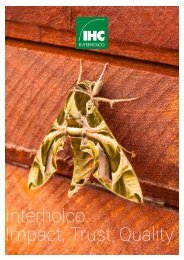Nomenclature Générale des Bois Tropicaux - 7ème édition
(english description below) Cette nomenclature est utilisée pour la mise à jour du 'Harmonized Code System' de l’Organisation Mondiale des Douanes. Dans la circulaire du 5 avril 2005, le Ministère de l’Economie, des Finances et de l’Industrie (France) reconnaît l’ATIBT comme « gardien du temple » de la nomenclature des bois tropicaux. La Commission Européenne mentionne la nomenclature de l’ATIBT comme document de référence pour la mise en œuvre du RBUE. Depuis 1954, l’ATIBT a établi et mis à jour une nomenclature des bois tropicaux faisant correspondre chaque espèce botanique avec un nom pilote reconnu internationalement. La détermination du nom pilote d’une essence est cruciale, car sa commercialisation dépend très largement de l’adoption de ce nom par le public. Le nom pilote assure la protection de l’appellation commerciale de l’essence et l’intégrité des propriétés qui lui sont attribuées, sans risque de confusion. The 1982 version of the general timber nomenclature has finally been updated as some of the 1,750 identified species, are no longer traded, while others, which were not previously included, are now on the market. The present revision has also integrated changes related to new taxonomy, in order to reflect the latest scientific developments. This Nomenclature has been used for the Harmonized Code System, updated by the World Customs Organization. The French Ministry of economy, finance and industry has given official recognition to ATIBT as the reference for the tropical timber nomenclature (NOR: PRMX0508285C of April 5th 2005). The European Commission refers to ATIBT nomenclature as a reference document for the implementation of the EUTR regulation. Since 1954, ATIBT has established and updated a nomenclature of tropical wood, linking each botanical species with an internationally recognized pilot name. A sigle wood species may have many common names; when trading across different countries, this may lead to confusion. Fixing the pilot name of a timber species is crucial, to protect the commercial denomination of the species and guarantee the veracity of the properties linked to that species, without confusion.
(english description below)
Cette nomenclature est utilisée pour la mise à jour du 'Harmonized Code System' de l’Organisation Mondiale des Douanes. Dans la circulaire du 5 avril 2005, le Ministère de l’Economie, des Finances et de l’Industrie (France) reconnaît l’ATIBT comme « gardien du temple » de la nomenclature des bois tropicaux. La Commission Européenne mentionne la nomenclature de l’ATIBT comme document de référence pour la mise en œuvre du RBUE.
Depuis 1954, l’ATIBT a établi et mis à jour une nomenclature des bois tropicaux faisant correspondre chaque espèce botanique avec un nom pilote reconnu internationalement. La détermination du nom pilote d’une essence est cruciale, car sa commercialisation dépend très largement de l’adoption de ce nom par le public. Le nom pilote assure la protection de l’appellation commerciale de l’essence et l’intégrité des propriétés qui lui sont attribuées, sans risque de confusion.
The 1982 version of the general timber nomenclature has finally been updated as some of the 1,750 identified species, are no longer traded, while others, which were not previously included, are now on the market. The present revision has also integrated changes related to new taxonomy, in order to reflect the latest scientific developments.
This Nomenclature has been used for the Harmonized Code System, updated by the World Customs Organization. The French Ministry of economy, finance and industry has given official recognition to ATIBT as the reference for the tropical timber nomenclature (NOR: PRMX0508285C of April 5th 2005). The European Commission refers to ATIBT nomenclature as a reference document for the implementation of the EUTR regulation.
Since 1954, ATIBT has established and updated a nomenclature of tropical wood, linking each botanical species with an internationally recognized pilot name. A sigle wood species may have many common names; when trading across different countries, this may lead to confusion. Fixing the pilot name of a timber species is crucial, to protect the commercial denomination of the species and guarantee the veracity of the properties linked to that species, without confusion.
Create successful ePaper yourself
Turn your PDF publications into a flip-book with our unique Google optimized e-Paper software.
86 ///
Nomenclature générale des bois tropicaux 2016
PILOT NAME BOTANICAL NAMES COMMON NAMES
Siris, White
Ailanthus integrifolia Lam.
Ailanthus triphysa Alston
Ailanthus spp.
Sloanea Sloanea spp. Sloanea (NC)
Sobu
Sougué
Sucupira preta
Sugi
Sumauna
Sungkai
Suren
Suya
Tachi
Tali
Tamboril
Cleistopholis glauca Pierre
Cleistopholis patens Engl. & Diels
Cleistopholis spp.
Parinari excelsa Sabine
(Syn. Parinari holstii)
(Syn. Parinari tenuifolia)
Parinari spp.
Bowdichia nitida Benth.
Bowdichia virgilioides Kunth
Bowdichia spp.
Diplotropis martiusii Benth.
Diplotropis purpurea Amsh.
(Syn. Bowdichia guianensis)
(Syn. Diplotropis guianensis)
Diplotropis spp.
Cryptomeria japonica D. Don
Ceiba pentandra Gaertn.
(Syn. Bombax pentandrum)
(Syn. Ceiba thonningii)
Ceiba samauma K. Schum.
Peronema canescens Jack
Toona calantas Merr. & Rolfe
Toona ciliata M. Roem.
(Syn. Cedrela toona)
Toona sureni Merr.
(Syn. Toona febrifuga)
Pouteria speciosa Baehni
Tachigali albiflora Zarucchi & Herend.
Tachigali chrysophylla Zarucchi & Herend.
Tachigali myrmecophylla Ducke
Tachigali paniculata Aubl.
Tachigali spp.
(Syn. Sclerolobium spp.)
Erythrophleum guineense G. Don
Erythrophleum ivorense A. Chev.
Erythrophleum suaveolens Brenan
Erythrophleum spp.
Enterolobium contortisiliquum Morong
Enterolobium cyclocarpum Griseb.
Enterolobium maximum Ducke
White Siris (AU) ; Kayu Langit (IN) ; Malakamias
(PH) ; Cang Hom Thom (VN)
Avom (CM, GA) ; Bofu (CI) ; Lukunzu (CG) ; Otu
(NG) ; Ovok (CM, GA) ; Sobu (CI)
Assila (CM) ; Eshago (NG) ; Inyi (NG) ; Kpar (LR) ;
Mampata (SN) ; Mubura (UG) ; Mula (TZ) ; Sougué
(CI)
Alcornoque (VE) ; Arenillo (CO) ; Baaka Kiabici
(GF) ; Chontaquiro (PE) ; Coeur Dehors (GF) ;
Congrio (VE) ; Cutiuba (BR) ; Huasai caspi (PE) ;
Macaniba (BR) ; Sapupira (BR) ; Sucupira (BR) ; Sucupira
preta (BR) ; Tatabu (GY) ; Zapan negro (CO) ;
Zwarte Kabbes (SR)
Cryptomeria (RE) ; Liusan (CN, TW) ; San-Sugi
(CN, TW) ; Sugi (JP)
Bonga (CO) ; Ceiba (BO, CO, PE, VE) ; Ceiba
Uchuputu (EC) ; Ceiba Yucca (VE) ; Fromager (GF) ;
Guambush (EC) ; Huimba (PE) ; Kankantrie (SR) ;
Koemaka (SR) ; Kumaka (GY) ; Mahot coton (GF) ;
Mapajo (BO) ; Paneira (BR) ; Silk Cotton (GY) ; Sumauma
(BR) ; Sumauna (BR) ; Toborochi (BO)
Cherek (MY) ; Jati Londo (ID) ; Jati Putih (ID) ; Jati
Sabrang (ID) ; Kurus (ID) ; Sukai (MY) ; Sungkai
(ID)
Calantas (PH) ; Chomcha (KH) ; Limpagna (IN) ;
Petsut Yetama (MM) ; Red Cedar (AU, PG) ; Surea-Bawang
(MY) ; Suren (ID) ; Surian (ID) ;
Thitkado (MM) ; Toon (IN, TH) ; Xoan Moc (VN) ;
Yomham (TH)
Chuya (GY) ; Durban Pine (GY) ; Pajura (BR) ; Pajura
de Obidos (BR) ; Por (GY) ; Suya (GY)
Aparaçu (BR) ; Cedre Remi (GF) ; Congrio (VE) ;
Diaguidia (GF) ; Djarkidja (SR) ; Djedoe (GY) ; Guabillo
(EC) ; Guamillo (VE) ; Kaditiri (GY) ; Matapalo
(EC) ; Pacuare (BR) ; Roode Djedoe (SR) ; Tachi
(BR) ; Tachigalia (BR) ; Tachi preto (BR)
Alui (CI) ; Elondo (GQ) ; Elone (CM) ; Eloun (CD,
GA) ; Erun (NG) ; Gogbei (SL) ; Kassa (CD) ; Mancone
(GW) ; Missanda (MZ) ; Muave (ZM) ; Mwavi
(TZ) ; N’Kassa (CG) ; Potrodom (GH) ; Sasswood
(NG) ; Tali (CI, SN)
Camba-Camby (AR) ; Carito (CO) ; Caro-Caro
(VE) ; Oreja de negro (AR) ; Orejero (CO) ; Para
(AR) ; Tamboril (BR) ; Timbauba (BR) ; Timbó (AR,
BR, PY) ; Timbo colorado (AR, PY) ; Timbóuba (BR)














